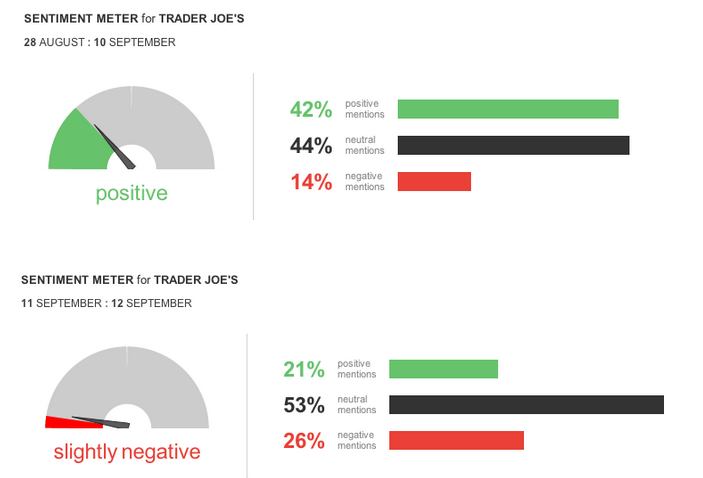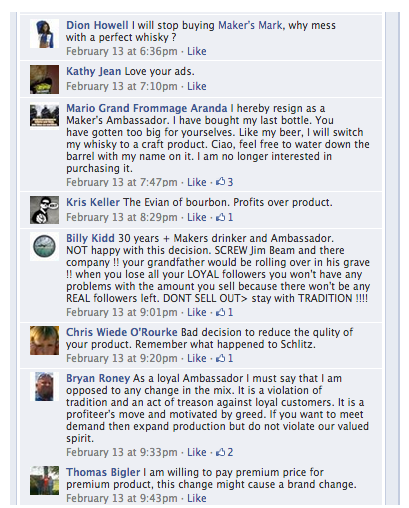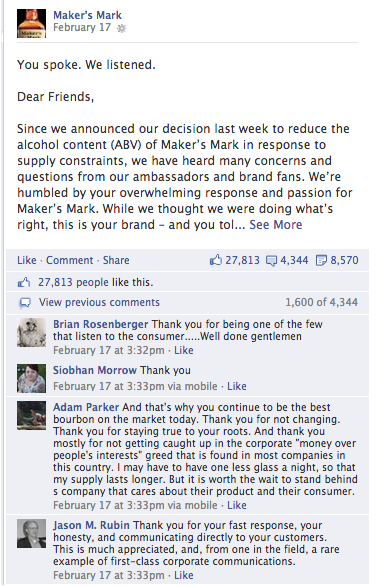Everyone wants to be liked. Brands and companies are no different. It’s important for consumers or clients to have a high opinion of your product or services because they will buy products and use services of brands they like. It’s that simple. One very important metric for determining if consumers like you is to measure your social sentiment level.
So what exactly is sentiment? It’s an emotion or how a person feels about something—like your brand. Social media monitoring tools like uberVU analyze social mentions and assign either a positive, negative or neutral sentiment to each mention, which gives companies an inside look at how the social web views them. Tracking the sentiment of mentions about your brand or company can help you gauge the health of your social communities and your overall reputation. Are people talking positively or negatively about your brand?
If your sentiment level is less than stellar, don’t fret—there are ways to improve it. Follow these five tips to change your sentiment from negative to positive or to raise your positivity even higher.
1. Expand Your Presence
Are you seeing negative sentiment levels on a specific platform? Is your brand active on that platform? The first step to improving your sentiment level is to make sure there are no holes in your social media presence. This doesn’t mean you have to participate on every single social network, but it does mean you need to be paying attention to what’s being said about your brand and where in order to determine where your brand should be.
Research where conversations relevant to your brand are taking place. Does most of your audience use Twitter for news? Do they like to dive into longer topics on Facebook? Are they Instagram junkies? Discover where they go online and make sure you have a presence there. That way you’ll be able to not only monitor what’s being said about your brand but also participate in the conversation.
Imagine there is a weekly Twitter chat about your industry where users talk about the latest and greatest products. One of your products is discussed and people have questions, but your brand doesn’t have an official Twitter account—that’s a problem. If you were on Twitter you could help answer people’s questions and provide other helpful information, which could reflect positively on your brand, leading to positive mentions of your brand.
Having a social media presence is especially important for maintaining your reputation. Participating in social will not only allow you to monitor what’s being said but also gives you a platform to tell your company’s side of the story. All it takes is one PR disaster to change your positive sentiment to negative, which Trader Joe’s is learning the hard way.
On September 11, it was reported that the grocery chain planned to drop health care coverage for part-time workers. Social media revolted against the brand and its sentiment dropped. We’ve been tracking the brand in the uberVU dashboard and it was consistently maintaining a high sentiment level—the morning the news broke we posted a Social Media Face Off featuring Trader Joe’s registering its sentiment at 42% positive. One day after the story broke it dropped to 26% negative. And where was Trader Joe’s during the firestorm? Not on social media—the brand doesn’t have any official social channels.
2. Listen and Actually Hear
As a social media professional you’ve no doubt been lectured on the importance of engagement—how it’s a must to reply to comments, answer questions and actively participate in the conversation. Engaging with your audience and listening to what they’re saying in social is important, but what’s even more important is that you hear them.
The more you listen, the better you’ll be able to respond to specific needs of your audience, which will help you provide content or services they want—which means higher satisfaction (i.e. positive sentiment).
Maker’s Mark recently proved how valuable listening can be when it came under fire for its decision to lower the alcohol content of its bourbon from 90 proof to 84 proof. As you can see from these comments on the brand’s Facebook page, people were pretty angry about the proposed change.
Maker’s Mark truly heard the concerns of its fans in social and took action, deciding not to lower the proof, posting a letter from its Chairman and COO on Facebook and Twitter to announce the news and thank fans for their passion. Social was pleased—comments poured in, filled with positive phrases like “best,” “well done,” and “first class,” raising the brand’s sentiment level that had crashed over the controversy.
3. Embrace Negativity
It can be easy to write off complaints. Some people are never happy, right? This might be true, but the fact is some negative comments can be turned around—don’t ignore them. Helping to resolve an issue or simply just apologizing for an inconvenience can help change people’s opinions about your brand. Plus, responding to negativity openly, and actively helping to solve problems shows that your brand is listening and cares about its fans.
JetBlue does a great job responding to negativity in social. The airline is quick to apologize for customers’ frustrations and tries to find ways to help. Take a look at this exchange where a customer complained using the word “disappoint”, which would register this comment as negative. JetBlue was quick to reply and offer an explanation for the person’s problem. The outcome? The customer calls the airline the “best” in her reply, which would register the mention as positive. Negative to positive with one reply—not too shabby.
Never thought JetBlue could disappoint me. No dogs over 20 lbs. No way my marathon training buddy could be under 20! pic.twitter.com/Dudu7QDO8H
— Angelina Daetz (@justicewithlove) September 17, 2013
.@JetBlue Dogs aside, you have the best fleet out there! No doubt.
— Angelina Daetz (@justicewithlove) September 17, 2013
4. Have a Customer Service Plan in Place
According to Nielsen’s 2012 Social Media Report, over half of consumers use social media to directly reach out to companies to ask questions or voice complaints. And one in three social media users prefer contacting companies in social rather than calling customer service numbers. Not only do they prefer using social, they also expect companies to provide direct access to customer support within social. Clearly, you need to have a customer service plan in place.
Not every brand or company will want or be able to conduct full-blown customer service in social media, but that doesn’t mean you get to ignore complaints or requests for help. Set up a plan for how you will handle these and stick to it. The outlet for customer service will be different for every brand. Perhaps you’ll set up a dedicated Twitter handle for customer service or you’ll call those who have complained in social. Whatever the case, respond promptly to customer complaints or questions, help right then if you can or direct them to your customer service team (phone number, email, dedicated Twitter handle, etc) if you can’t.
Online shopping site Rue La La does a great job of handling problems reported by their customers. They display genuine concern and always offer a way to help, directing customers to contact a separate customer service twitter handle to better address issues. Rue La La Concierge helped answer this customer’s fairly simple question and got some serious kudos back—“great” and “amazing” = positive sentiment.
@lifeofmarge You’ll be able to place it on 7/19. (We’ll be sending your redemption email with proper codes to place your order on RTR then!)
— Rue La La Concierge (@RueLaLa_help) July 17, 2013
@lifeofmarge You’re so welcome – thrilled that I could help!
— Rue La La Concierge (@RueLaLa_help) July 3, 2013
Want to see how other top brands are using social for customer service? Learn best practices and what to avoid in our cheat sheet for social.
5. Own Up
One of the biggest mistakes a company can make is waiting to acknowledge a problem or mistake. Whether it’s a full-blown brand crisis or just a simple mistweet, it is best to respond quickly by acknowledging the issue and ensuring your fans that you’re looking into it or detailing what you’re doing to fix the issue.
Choosing to ignore issues will not reflect well on your brand. People understand that mistakes happen, but they won’t stand for a cover-up or having the problem ignored. The longer you stay silent in social, the faster negative comments will roll in, quickly dropping your sentiment level.
Try to get ahead of a potential rise in negative feedback by addressing any issues or stories about your brand that might be making news (or soon will). Be as transparent as possible. If something is bothering your community or if your brand is experiencing some negative press, talk about it.
Southwest is a great example of a company that handles any potential crisis with honesty and transparency. When a problem happens, the airline is quick to take to social to update consumers. In July of 2013 there was an emergency evacuation of a Southwest plane at New York’s LaGuardia airport. Southwest quickly took to Facebook to confirm the problem and continued to provide updates along the way, much to the satisfaction of fans.
Problems might not start in social, but they will end up there. Rather than waiting for the news to spread Southwest addressed the issue right away with the facts and continued to update the public. As you can see from the comments, the brand’s efforts were appreciated and congratulated, which was no doubt reflected in its sentiment level.
Get Positive!
There you have it: five ways to improve your social sentiment. Want to learn other ways to increase your brand’s overall social likeability? Learn the four main community/social media manager qualities that consistently lead to flourishing online communities. Plus, get expert insights into social from some of our favorite brands’ community managers in our Getting Social interview series.




